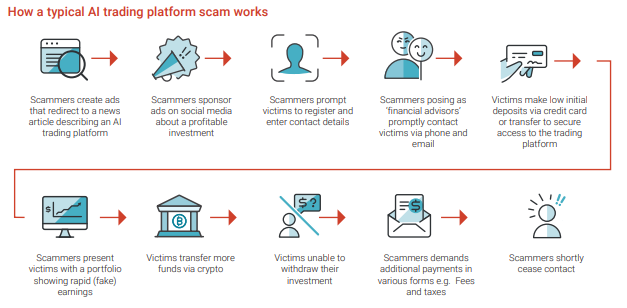Information for this article has been extracted from https://www.accc.gov.au/system/files/NASC-Investment-scam-fusion-cell-final-report-2024.pdf
Investing can be a fantastic way to grow your wealth, but it’s also a playground for scammers looking to make a quick buck. In Australia, investment scams are becoming more common and sophisticated. Knowing how these scams work and how to avoid them can save you a lot of trouble and money.
What are investment scams?
Investment scams trick you into handing over your money with promises of high returns and low risk. These scams come in many forms, such as fake stocks, Ponzi schemes, and cryptocurrency frauds. Scammers are getting pretty good at making their schemes look legitimate, so it’s essential to stay informed and cautious.
Recent investment scams
Imposter bond and term deposit scams
Imposter bond and term deposit scams deceive people into believing they are investing with a legitimate company or bank. People are most often exposed to these scams when they are conducting online research into low-risk investment opportunities, for example, when on digital platforms or searching for market rates for investments in term deposits and bonds.
In 2023, Scamwatch received more than 440 reports of imposter bond and term deposit scams, with total reported losses amounting to more than $41 million. For those that reported a loss, the average amount lost was around $264,000. While the number of reports may seem limited these scams are the highest average loss category and interventions which focus on this scam type have high impact.

AI trading platform scams
AI trading platform scams claim to leverage AI software and emerging technology to generate high returns with minimal effort or expertise from the investor. These scams often target inexperienced investors who are not actively looking for investment opportunities. They are enticed by advertisements and online news articles featuring fake celebrity endorsements to start online trading, for a low upfront cost. Advertisements promote trading in foreign exchange, contracts for difference (CFD) derivatives, or cryptocurrency and consumers are given access to an online trading platform which appears to show early trading success, followed by losses. Consumers are often given trading credits to ‘trade’ their way out of illusory losses and then incur an apparent debt which they are required to repay.
Based on conservative estimates, Scamwatch received 400 reports of AI trading platform scams with reported losses totalling more than $8 million in 2023. For those that reported a loss, the average amount lost was around $30,000.
However, the true losses reported in 2023 are likely to be closer to $20 million, with more than 600 reports to Scamwatch featuring common methodology used in AI trading platform scams. Given the increasing prominence of AI, AI trading platform scams represent an emerging scam trend requiring urgent disruption.

Red flags to look out for
- Unbelievable returns: High returns with little to no risk are usually a red flag. If it sounds too good to be true, it probably is.
- Pressure to invest quickly: Scammers often push you to make a quick decision. They don;'t want you to have time to think it over.
- Unregistered investments: Legit investments are registered with financial authorities like ASIC. Check the Investor Alert Link if you are unsure.
Protect yourself
- Do your research: Look into the investment and the people offering it. Use trusted sources and verify their credentials.
- Check registration: Make sure the investment is registered with ASIC or other relevant authorities.
- Get professional advice: Talk to an financial advisor before making any significant investment decisions.
- Stay informed: Keep up with the latest scam tactics and be alert to anything suspicious.
- Report scams: If you think you've encountered a scam, report it to Scamwatch.
Investment scams can be a serious threat to your financial wellbeing. By staying informed, doing your homework, and using resources like Scamwatch, you can protect yourself from falling victim to these fraudsters. Remember, it’s always better to be safe and cautious when it comes to your money.

